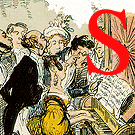The following discussion is note 41 to the author’s Unwilling Moderns: The Nazarene Painters of the Nineteenth Century.

ome recent studies may overemphasize the nationalist, "Germanic" tendency of the Nazarenes. The latter were certainly aware of being "Teutsche," they sought out and gave encouragement to other "Teutsche," and they generally supported some kind of German national unity (Napoleon had disbanded the old Reich in 1806). Philipp Veit, Friedrich Olivier, and Johann Scheffer von Leonhardshoff took an active part in the Befreiungskriege. But there was nothing narrow or chauvinist about the Nazarenes’ patriotism. The fact that so many of them converted to Catholicism is a sign that their patriotism bore no resemblance to modern demagogic nationalism. Another such sign is the frequent association, in their imagery, of figures representing the union in friendship of Germany and Italy, Nuremberg and Rome, Dürer and Raphael, and even—in the case of Joseph Anton Koch, who hoped to complement his Landscape with St. Martin of 1815 with a St. Bonifatius Demolishing the Temple of Jupiter, thus representing both the patron saint of France and the "apostle" to the Germans—Germany and France. See Die Nazarener, exh. cat., Städelsches Kunstinstitut, Frankfurt am Main, 1977, p. 63.
Above all, the decision to settle in Rome marks a striving toward what was believed to be fundamental, enduring, and universal and an opting out of the dramatic turmoil of contemporary history, which may well have seemed to these ardent and idealistic young men as ephemeral and superficial as the representations of the immediate experience of things on canvas that they rejected in art. To Wilhelm Wackenroder, whose Herzensergiessungen eines kunstliebenden Klosterbruders (1797) was one of the chief sources of inspiration of the Nazarene movement, the fact that Odin and Thor were "vaterländische Götter" seemed an odd justification for the current interest in Germanic mythology. "Was will man denn in unsern Zeiten mit dieser Vaterlandsliebe?" he scoffed. "Doch scheint jetzt eine gewisse Mode hierin zu herrschen. Gemeine Schullehrer scheinen wirklich zu glauben, dass sie wer weiss wie grosse Fortschritte in der Pädagogik gemacht haben, wenn sie ihren 8-jährigen Knaben jetzt die Brandenburg[ische] Gesch[ichte] d[es] Vaterlands recht weitläufig erzählen. Ein Bürger…braucht doch in unseren Zeiten im Grunde die vaterl[ändische ] Gesch[ichte] so wenig als eine andre, und es würde, nach meiner Meynung, also zweckmässiger seyn, wenn man irgend eine interessante Gesch[ichte], ohne Rücksicht ob dieses oder jenes alten oder neuen Volks, in unteren Schulen vorträge." See his letter to Ludwig Tieck, 5 May 1792, in Silvio Vietta and Richard Littlejohns, eds., Sämtliche Werke und Briefe, 2 vols. (Heidelberg: Carl Winter Universitätsverlag, 1991), vol. 2, p. 30.
Seventy years later, in 1865, with nationalist sentiment growing ever stronger in Germany, Overbeck, still resident in Rome, reaffirmed that he was a Christian first and only "demnach Deutscher" and that, without any diminution of his affection for his homeland, he considered that "the heavenly fatherland was incomparably higher than the earthly one." See Margaret Howitt, Friedrich Overbeck. Sein Leben und Schaffen. Nach seinen Briefen und andern Documenten des handschriftlichen Nachlass geschildert, 2 vols., ed. Franz Binder (Freiburg im Breisgau: Herder, 1886; reprint Bern: Herbert Lang, 1971), vol. 2, p. 385. The liberal art historian Karl Scheffler even claimed that the Nazarenes had no "lebendiges nationales Empfinden," and that "Es tritt eine nicht eben liebenswürdige Gleichgültigkeit gegen die politischen Schicksale Deutschlands zutage." Scheffler's claim that "nicht einer der Nazarener hat an den Freiheitskriegen teilzunehmen den Drang gehabt" is, however, false. See Karl Scheffler, Deutsche Maler und Zeichner im neunzehnten Jahrhundert (Leipzig: Insel-Verlag, 1920; 1st ed. 1909), pp. 16–17; and notes 69 and 140 below.
[Return to Unwilling Moderns]
13 August 2016